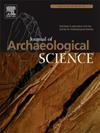Unravelling the past of cervid populations on the Pearl Island Archipelago (Panama) through a two dimensional geometric morphometric analysis of the lower third molar
IF 2.6
1区 地球科学
Q1 ANTHROPOLOGY
引用次数: 0
Abstract
This study investigates the evolutionary and morphological divergence of Neotropical cervids across mainland and island populations, integrating size, shape, and ecological data. Three extant cervid species were analyzed: Mazama temama, Odocoileus virginianus, and Passalites nemorivagus, San José Island cervids, alongside extinct archaeological samples from Playa don Bernardo (PdB) on Pedro Gonzalez Island from Pearl Island Archipelago (Central Pacific, Panama). Morphometric analyses of lower third molars (m3) revealed distinct evolutionary trajectories shaped by geographic and ecological isolation. Centroid size analyses reveal significant interspecies differences, with O. virginianus being generally larger than other groups, while PdB cervids exhibit reduced sizes potentially linked to insular dwarfism. Shape analyses, including PCA and Procrustes ANOVA, demonstrate distinct morphological patterns among species, with P. nemorivagus showing unique traits, while PdB cervids cluster closely with O. virginianus and San José Island cervids. Canonical variate analysis (CVA) and phenotypic trees corroborate these relationships, highlighting evolutionary divergence influenced by ecological pressures. Statistical tests reveal significant species-level effects on size and shape, with minimal contributions from sex or species-sex interactions. Procrustes distance comparisons emphasize substantial morphological divergence between P. nemorivagus and other groups, while PdB cervids share closer morphological affinities with San José Island cervids and O. virginianus. These findings suggest a complex evolutionary history shaped by environmental constraints and isolation, underscoring the role of insular environments in driving morphological diversity among Neotropical cervids.

通过对下第三磨牙的二维几何形态分析,揭示了珍珠岛群岛(巴拿马)上cervid种群的过去
本研究通过整合大小、形状和生态数据,探讨了大陆和岛屿种群中新热带cerids的进化和形态差异。本文分析了三种现存的cervid物种:Mazama temama, Odocoileus virginianus和Passalites nemorivagus, San josore岛的cervid物种,以及来自巴拿马珍珠岛群岛(Central Pacific) Pedro Gonzalez岛上Playa don Bernardo (PdB)的灭绝考古样本。下三磨牙(m3)的形态计量学分析揭示了地理和生态隔离形成的独特进化轨迹。质心大小分析揭示了物种间的显著差异,O. virginianus通常比其他类群更大,而PdB cerids则表现出较小的尺寸,这可能与岛屿侏儒症有关。形态分析(包括主成分分析和Procrustes方差分析)显示了不同物种的形态特征,其中P. nemorivagus具有独特的特征,而PdB cervidus与O. virginianus和San jossise Island cervidus密切相关。典型变量分析(CVA)和表型树证实了这些关系,强调了受生态压力影响的进化差异。统计测试显示,物种水平对大小和形状有显著影响,性别或物种间相互作用的影响最小。Procrustes距离比较强调了P. nemorivagus与其他类群在形态上的显著差异,而PdB cervers与San jossev Island cervers和O. virginianus在形态上的相似性。这些发现表明,环境约束和隔离形成了一个复杂的进化史,强调了岛屿环境在推动新热带cerids形态多样性中的作用。
本文章由计算机程序翻译,如有差异,请以英文原文为准。
求助全文
约1分钟内获得全文
求助全文
来源期刊

Journal of Archaeological Science
地学-地球科学综合
CiteScore
6.10
自引率
7.10%
发文量
112
审稿时长
49 days
期刊介绍:
The Journal of Archaeological Science is aimed at archaeologists and scientists with particular interests in advancing the development and application of scientific techniques and methodologies to all areas of archaeology. This established monthly journal publishes focus articles, original research papers and major review articles, of wide archaeological significance. The journal provides an international forum for archaeologists and scientists from widely different scientific backgrounds who share a common interest in developing and applying scientific methods to inform major debates through improving the quality and reliability of scientific information derived from archaeological research.
 求助内容:
求助内容: 应助结果提醒方式:
应助结果提醒方式:


